Main Content
The Commodification Gap. Gentrification in London, Berlin and St. Petersburg
New Book by Matthias Bernt

Matthias Bernt, acting head of the Research Area Politics and Planning, examined gentrification processes in London, Berlin and St. Petersburg comparatively in his habilitation project "Gentrification and Housing Policy". He paid special attention to the effects of different forms of regulation and policies of the housing market, both on investments in the housing stock and on the displacement of low-income households. From his findings, Bernt developed the concept of the "comodification gap", which takes an institutionalist perspective on gentrification. Now his habilitation thesis is published as a monograph by Wiley.
Gentrification, the "upgrading" of residential areas through the displacement of poorer residents and the influx of higher earners, has long been a core topic of urban research. Since the term was introduced by the sociologist Ruth Glass in 1964, two main explanations have been discussed: "supply-side" approaches derive the upgrading process of neighbourhoods from the difference between currently realised land rent and potentially possible rent from a property, the so-called "rent gap". If the gap is large enough, it becomes attractive to invest in the neglected housing stock. Rent increases and displacement of lower-income residents follow. "Demand-side" explanations tend to locate the causes of gentrification processes in socio-structural, demographic and cultural processes. They assume that gentrification is fuelled when more people with purchasing power demand certain residential locations and price classes.
Both approaches are subject to criticism because they were developed against the background of the experiences of US and British cities in the 1970s and 1980s and largely leave out factors such as the political regulation of housing markets. As a result, upgrading processes in very different places are, in a sense, lumped together. This is where Matthias' book "The Commodification Gap: Gentrification and Public Policy in London, Berlin and St. Petersburg" comes in, in which he comparatively investigated gentrification processes in London, Berlin and St. Petersburg from 2014 to 2017, pursuing two key questions: What influence do different forms of regulation of the housing market have on investments in the housing stock? And: How do different policies affect the displacement of low-income households?
In his project "The commodification gap. Gentrification in London, Berlin and St. Petersburg", Matthias Bernt developed a new institutionalist perspective on gentrification. Central to this is the new concept of the "commodification gap", which looks at the relationship between general economic conditions and local institutional contexts. The commodification gap thus describes the difference between the potential land rent that can be achieved for a property when it is fully commodified and the land rent that can be achieved when the commodity character of the property is fully or partially restricted. This can be done, for example, through rent legislation or social housing status. It is only when this gap is closed that gentrification takes place. Bernt identified a total of eleven different commodification gaps that can be used to describe the institutional framework for gentrification in their respective national contexts at different points in time. These include, for example, the gap between basic rents for "unmodernised" and "modernised" housing under German tenancy law, the possibility of "upgrading" privatised social housing in the UK, or the fragmentation of ownership in Russia.
The book is published in April 2022 in the renowned "IJURR Studies on Urban and Social Change Book Series" by Wiley.

